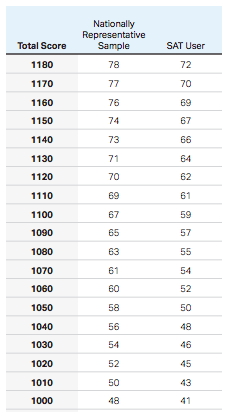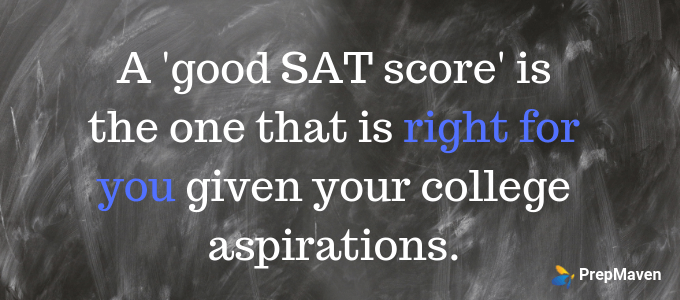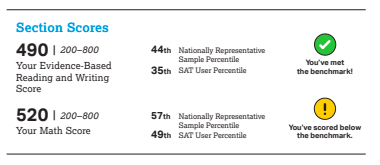Average Reading And Writing Sat Score
What is a Good SAT Score for 2021? (And 6 Steps to Get One)
Bonus Material: SAT Score Ranges for 499 U.S. Colleges
What is a good SAT score? And how do you get one?
Our students ask these 2 questions all the time. But answers to them can vary widely, depending on who you ask.
In this post, we use up-to-date industry data to define a good SAT score for 2021.
Yet we won't leave you hanging there.
We also give insight into what makes for a good SAT score for you personally . Plus, we outline 6 actionable steps for getting closer to that target score.
Students who take the time to figure out their personally great SAT scores are more likely to achieve college admissions success.
We also give readers access to the SAT score ranges of competitive applicants to the tope 499 U.S. colleges, which you can download below.
Here's what we cover:
- Our 2 Data-Backed Definitions of a "Good SAT Score" for 2021
- How Many Questions You Need to Get Right to Achieve a Good SAT Score
- "Bad" SAT Scores — Do They Exist?
- 6 Steps for Getting a Good SAT Score (that you can easily start today)
- Bonus : SAT Score Ranges for 499 U.S. Colleges
Your Guide to a Good SAT Score for 2021
Students taking the SAT for the first time often ask these two questions:
- What's a good SAT score?
- What do I need to do to get a good SAT score?
That first question can be tough to answer. After all, "good" is a relative term, right? And isn't every single SAT technically different?
Yes and yes.
That's why it's so important to define what we actually mean by a "good SAT score." We have 2 definitions for this.
Our 2 Definitions of A Good SAT Score
- "Good" is anything that is "above average" with sectional scores and percentile rankings
- "Good" is anything that will look competitive on a college application
Let's start with the first definition.
Good SAT Score #1: The "Above Average" SAT Score
Average SAT Scores
With this definition, in very basic terms, a good SAT score for 2021 could be anything above 1051 . This was the average national composite SAT score for the graduating class of 2020.
A good SAT Reading and Writing score could be anything above 528 and a good SAT Math score could be above 523 , based on the same data released by the CollegeBoard in its 2020 annual report.
Percentiles
But we like to be more precise than this.
Remember that an SAT score–composite or section–always comes attached to a percentile ranking. This percentile indicates the percentage of comparison students an individual test-taker out-performed.
There are two comparison groups: "SAT Users" (actual SAT test-takers from the classes of 2019 and 2020) and a "nationally representative sample," weighted percentiles derived from a research study of 11th and 12th grade U.S. students.
Because these comparison groups are different, the percentiles are likely to vary, as you can see in this sampling below:

A student who scores 1080 on the SAT in 2021, for example, will likely have a composite percentile of 78 (nationally representative sample) and 72 (SAT user percentile). This means that this student out-performed roughly 72-78% of SAT test-takers across these two comparison groups.
SAT scores are also usually normally distributed. This means that the bulk of students' composite SAT scores hover around the middle of the curve. Far fewer scores appear on the higher or lower end of the SAT score range between 400 and 1600.

The middle-of-the-road (or median) SAT composite percentile is the 50th. Students in this percentile range out-performed 50% of all test-takers and under-performed 50% of all test-takers. Students with a 1080 SAT composite are in this 50th percentile.
What does this mean?
Students who score higher than 1080 on the SAT are above average nationally from a percentile basis. These students also hold a 51% or higher SAT percentile.
Thus, a good SAT score on a national scale is above 1080.
Good SAT Score #2: The College Competitive SAT Score
Let's not forget about one major reason for taking the SAT: college entrance!
In the context of college entrance, one student's "good" SAT score could be vastly different than another student's. It just comes down to where you are applying and the average SAT scores of admitted applicants.
So, we like to say that, under this definition, a 'good SAT score' is the one that is right for you given your college aspirations . This will probably be close to the SAT scores of admitted applicants.
If a student is aspiring to attend a highly selective institution like Princeton University, for example, a "good" SAT score likely surpasses the 90th percentile.
Plenty of universities specify score ranges and percentiles of successful applicants on their websites (although some are not public with this information).
Most do so by specifying the 'Middle 50,' or the 25th and 75th percentile of accepted students' SAT scores– this is not to be confused with SAT score report percentiles!
Here's a sampling of the Middle 50s from various elite institutions:
| College | 25th Percentile Reading and Writing Score | 75th Percentile Reading and Writing Score | 25th Percentile Math Section Score | 75th Percentile Math Section Score |
| Yale University | 720 | 770 | 740 | 800 |
| Vanderbilt University | 710 | 760 | 750 | 800 |
| Amherst College | 650 | 740 | 660 | 750 |
| Pomona College | 690 | 750 | 700 | 790 |
| Princeton University | 710 | 770 | 750 | 800 |
| Brown University | 700 | 770 | 740 | 800 |
| Barnard College | 670 | 750 | 670 | 770 |
Source: The National Center for Education Statistics IPEDS (2019)
When researching competitive applicant SAT scores, keep in mind range .
Successful Vanderbilt applicants, for example, often have an SAT Reading and Writing score of 710-760. Successful Barnard College applicants have an SAT Reading and Writing score between 670 and 750.
Those ranges are actually significant. Yes, the higher your score in these cases, the better. But, technically, students on the lower end of these ranges still earned acceptance!
S ome institutions have test score and/or GPA cut-offs for scholarship considerations. Review these requirements ahead of time to identify score ranges for eligible applicants.

What about schools that don't explicitly state the average SAT scores of admitted applicants on their websites?
There's a workaround.
Many colleges also release what is called a Common Data Set, which presents data related to admitted applicants' test scores and more.
Princeton University's CDS , for example, includes the 25th and 75th percentiles of SAT scores as well as the percentage of 2019-2020 freshman students with specific SAT score ranges.
Based off of this data, we can conclude that a competitive SAT score for a Princeton applicant would fall within these ranges:
- Reading and Writing: 710-770
- Math: 750-800
- Composite: 1470 – 1560
You can also simply download these SAT Score Ranges for 499 U.S. Colleges, which includes the most recent data about SAT performance of competitive applicants.
What This Means In Terms of Questions
How many questions do you have to get correct on the SAT to earn a score that is above average (as per our first definition of a good SAT score)?
Every SAT exam is scaled for difficulty in a process the College Board calls "equating." We discuss this more in our guide to scoring on the SAT.
Because no two SATs are alike, it's difficult to translate the 2020 average SAT scores into total correct questions .
It is possible to generalize, however, which we have done in the following table.
| Section | Average 2020 Score | Average Questions Right |
|---|---|---|
| Evidence-Based Reading + Writing | 528 | ~46-52 questions right (out of 96) |
| Math | 523 | ~21-38 (out of 58) |
| Total | 1051 | ~67-90 questions (out of 155) |
Data based on raw score conversion tables for College Board Official Practice Tests 1-8.
Notice that average SAT performance boils down to getting just about (or over) 50% of all questions correct.
What is a Bad SAT Score? (Does it Exist?)
Is there such a thing as a bad SAT score? Kind of.
A "bad" SAT score often misses the mark of what the College Board has called college and career readiness. These scores are typically below-average in comparison to the mean.
They may also not meet the benchmark scores the College Board has established in terms of college preparedness, especially with respect to content areas. These benchmark scores vary according to grade (from 8th grade to 11th grade).
For the purposes of this article, we'll focus on the benchmark scores for college and career readiness.
- Evidence-Based Reading and Writing: 480
- Math: 530
Students who meet these benchmarks will see a green checkmark next to their scores. A yellow circle with an exclamation point indicates that a student has not met a benchmark for a given section.

Source: The College Board , Understanding SAT Scores
So, if you score below 480 on Evidence-Based Reading and Writing and 530 on Math, you're technically earning a "bad" SAT score. But remember 3 things:
- Every college will have different standards when it comes to SAT scores of admitted applicants
- 530 on SAT Math is actually above average (on sectional scores) compared to 2020 average SAT scores
- You can take the right steps for increasing your SAT score (with the tips we're about to talk about)
6 Steps for Getting a Good SAT Score (that you can easily start today)
Now we get to answer that third question mentioned in the intro to this post: What do I need to do to get a good SAT score?
1. Take a diagnostic SAT.
It's hard to figure out your destination if you don't know where you are starting in the first place!
Take a diagnostic SAT practice test to pinpoint where your skills currently lie. In fact, this is the first thing we have our students do when they sign up for any PrepMaven SAT test prep program.
A benchmark set of SAT scores is essential for creating reasonable goals. And reasonable goals are critical for reaching your target SAT score.
You can find 10 FREE Official SAT Practice Tests here.
We also recommend checking out our guide to self-proctoring your first SAT practice test–it's important to replicate Test Day conditions as much as possible in order to generate accurate results.
2. Make sure the SAT is actually the right test for you.
You heard that right.
The SAT might not be the test for you, depending on the results of your diagnostic SAT. Some students are better suited for the ACT, the other standardized test used in college admissions.
Colleges accept both tests equally, but it's important to prep for the test guaranteed to give you the highest score.
The ACT and SAT are similar in some ways. But they are also vastly different in others. To see which test is right for you, ask these 5 questions now.
If you're simply curious about the ACT, our post on the ACT's general format will give you a good overview of what to expect with this test.
We can also help students figure out which test to pursue in a free test prep consultation.
3. Build a general college list.
You might not be certain exactly where you'd like to apply to college.
That's okay!
Most high school students solidify their college lists the summer or fall of their senior years.
However, to truly know what a good SAT score looks like for you, a general college list is essential. This list can help you identify ballpark SAT score ranges for competitive entry, which we talk about in the next step.
If you aren't able to pinpoint exact colleges, think in terms of tier:
- Tier 1: Ivy League Schools (Harvard, Princeton, Yale, etc.)
- Tier 2: Extremely Selective Schools
- Tier 3: Highly Selective Schools
- Tier 4: Selective Schools
- Tier 5: Moderately Selective Schools
- Tier 6: Somewhat Selective Schools….. etc.
We recommend choosing 3 tiers of schools, arranged as follows, and at least 2 schools for each of these tiers (total of 6):
- Safety schools (you know you'll probably get in)
- Competitive schools (odds are neutral)
- Reach schools (a "reach" to earn acceptance)
Of course, students will want to keep building this college list as they progress with their SAT test prep. For now, however, a general list of at least 6 schools will be sufficient to get to the next step.
4. Investigate college score ranges.
Once you've assembled your general college list (with at least 6 schools), it's time to check out the average SAT scores of admitted applicants to these institutions. You have a few resources for this:
- The college's website itself
- The most recent Common Data Set for that college (if possible)
- National Center for Education Statistics IPEDS
- PrepMaven's SAT Score Ranges for 499 U.S. Colleges
Remember to keep in mind score ranges of admitted applicants and 25th / 75th percentiles (if applicable) as you do this research.
Let's say that you want to research the SAT score ranges for applicants accepted to Fordham University.
Fordham does specify test score ranges on its website (not all colleges do this):

We can also back this up with information from Fordham's Common Data Set from 2018-2019:


Do this for all 6 schools on your general list.
5. Identify your target SAT score
SAT test prep without a target score is like a ship without a rudder. A target SAT score is essential for 2 things:
- Setting goals
- Figuring out your test prep timeline
Before setting your target SAT score, we encourage you to:
- Take a diagnostic SAT practice test
- Assemble a general college list
A concrete target SAT score can mean the difference between a mediocre score and a good score. Why? You are more likely to reach your goals in life if they are:
- Specific
- Time-oriented and
- Realistic
In fact, students who don't choose a target SAT score at the start of their test prep are less likely to be successful in their journey.
6. Take your time
The SAT is vastly different from traditional high school tests. Much like a second language, it requires dedication, immersion, and time to understand and eventually master.
Thus, it's important to give your test preparation time . The SAT is not a test that students can cram, and nor should it take a side-burner in a student's college application process.
Allocate a generous timeline for sufficient SAT test prep, and stick to it!

Download SAT Score Ranges for 499 U.S. Colleges
We've compiled the SAT score ranges of successful applicants to the top 499 U.S. colleges in one simple document, which you can download for free below!

Here's what you'll get with this handy resource:
- Middle 50 SAT composite scores for the top 499 U.S. colleges and universities
- Middle 50 SAT sectional scores for Reading & Writing and Math
- Admit rate for each college
- All based on the most recent available data (2019)
 Kate
Kate
Kate is a graduate of Princeton University. Over the last decade, Kate has successfully mentored hundreds of students in all aspects of the college admissions process, including the SAT, ACT, and college application essay.
Average Reading And Writing Sat Score
Source: https://prepmaven.com/blog/test-prep/what-is-a-good-sat-score-2019/
Posted by: geistfairie.blogspot.com

0 Response to "Average Reading And Writing Sat Score"
Post a Comment